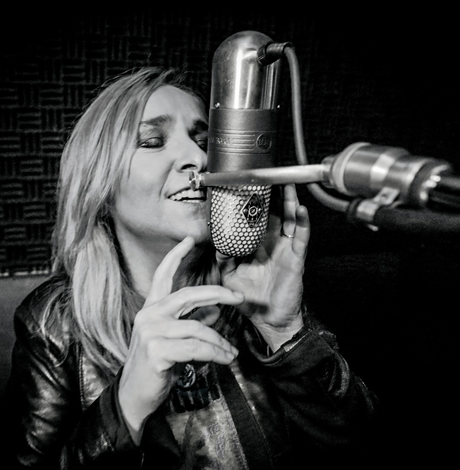a&e features
Sophie B. Hawkins goes deep in advance of D.C.-area concert
‘90s hitmaker known for ‘Damn, I Wish I Was Your Lover’ is on fall mini-tour


Sophie B. Hawkins will sing hits and new songs at her Saturday evening concert in Vienna, Va. (Photo by Shervin Lainez; courtesy No Big Deal PR)
Ellis Paul and Sophie B. Hawkins
Saturday, Oct. 28
6:30 p.m. (doors, 5:30)
Jammin Java
227 Maple Ave. E
Vienna, Va.
$25
Singer/songwriter Sophie B. Hawkins is at a place in her life where she’s being highly deliberate about what she does.
She’s sitting on a finished album but wants to figure out a way to release it strategically for maximum impact. A recurring theme in our lengthy phone chat last week is that there are lots of great ideas, but several are just not high on her priority list right now.
Newly single after nearly two decades in a same-sex relationship, the 52-year-old singer known for ‘90s radio staples “Damn, I Wish I Was Your Lover” and “As I Lay Me Down” is back in New York focusing on her art and raising her two young children, Dashiell, 8, and Esther, 2.
She makes a rare D.C.-area appearance this weekend at Jammin’ Java in Vienna, Va., on her fall mini-tour. Her comments have been edited for length.
WASHINGTON BLADE: How does it feel to be back in New York again after so many years in Los Angeles?
SOPHIE B. HAWKINS: Well I was born and raised in Manhattan so when I get home to New York or anywhere near, I feel a certain accessibility to my soul. I feel like this is where I came into the world, where I’m coming back to and where I’m allowed to be me. I can be my age here, I can be a single woman, so exotic and excited to be alive, just in the day, and it’s not weird. I don’t have to drive a fancy car, I don’t have to wear makeup, I can just live and enjoy everyone’s energy and creativity. That’s the difference between L.A. and New York. In California, it’s harder to connect with people and harder to connect with people’s creativity. In New York, it’s very much coming up from the ground.
BLADE: What can we expect at your show this weekend and why are you doing a mini-tour now?
HAWKINS: This mini-tour came about for a very specific reason. I wanted to go out and do solo shows without one single musician, just me because I’d never done that before until weekend before last. I did it in Massachusetts and Maine and I really felt like this was the time for me to just go on stage and really see if I’m a good-enough musician and good-enough artist and good-enough storyteller to get out there and be the person that I am (in my home studio) working and writing songs. … I loved the last two shows. They were my favorites in a very long time because I just got up there with my instruments, my banjo, my drums, my guitar and my piano, and I sang the songs and it was so relaxed and emotional and, of course, intimate, but it was something more. Sort of a heightened experience. … I wouldn’t say it’s me being me because I’m always me, but it’s really one on one. It’s scary but that’s where I really like it the best.
BLADE: How was it received?
HAWKINS: Both audiences, and not that this should ever happen again, but they both gave me standing ovations and they all came back and it was a different conversation after the show. … It really could have gone terribly — that’s why I didn’t do it in New York. I could have walked off the stage and said, “I’m never doing that again,” and called my guitar player. But I’m actually excited to do it more.
BLADE: You’re working on a musical, you have a new album in the can, you did the Janis Joplin play a few years ago and said you even wrote some songs as Janis. What all will you be singing? Stuff from your albums or some of that stuff as well?
HAWKINS: Well, OK, first of all, I’m always going to do my hits. They’re beautiful and I just want people to know they won’t get deprived of that. The second thing is I’m definitely doing some new songs. People seem to really love the new songs and I’m doing one I just wrote a couple weeks ago that’s a brand new original Christmas song so it’s going to be exciting to do one that I just wrote. As for the album, I’m going to be totally candid because I always am, I don’t quite know how to get it out. I don’t want it to just be the same old process of putting all this effort into something and then making no money from it. I’m trying to find a new way and really taking my time. I really love it, I put a ton of energy into it and the songs are, in my opinion, phenomenal so I don’t want to just throw it out and have it go nowhere. The musical is still a work in progress. … I may put the Christmas song out just to have a little something but … I can’t just throw things out there anymore.
BLADE: You did some shows in New York back in June that you said you were going to record to try to capture something elusive you said doesn’t always show up on your studio work. Did you?
HAWKINS: Yes, well, I don’t know if I captured that elusive whatever but I did record all three shows and they were filmed. I don’t know if the filming was good because I haven’t seen it yet. … I’m not sure if I’m going to edit them and put anything out because that takes so much work. I wish I had another me to do that kind of work. And sometimes you’re just too close to it. I thought it sounded terrible when I listened to it in June but then I heard it again in September by accident and I was like, “No, that sounds pretty good, I should get to editing that.” … But again, it goes back to not wanting to just put stuff out just to do it. I’m looking for a right connection. I’m not dying for people to say, “Oh she’s great, listen to this,” and then move on to the next thing. There’s no reason for that. Maybe once I figure out when the album is coming out, the live stuff could be like the thank you for being part of my life and here is this gift.
BLADE: What has it been like rebuilding after going through the break-up of a 17-year relationship?
HAWKINS: Oh, it was awful. Just so incredibly sad, I can’t even tell you. … It’s still so difficult to understand how that could have happened. … I felt like I was saved when I got back to New York … by the skin of my teeth. There’s this amazing other part of yourself that says, “I’ve got to move before the tsunami hits, I gotta get out of my bed and start running” and that’s what happened. The tsunami was coming down on me and my son and I actually got out of bed and said, “We’re getting up now, move, move, move, get the dogs,” and we got to New York and boom, we would have been dead if we’d stayed a moment longer. And I mean completely dead emotionally, psychologically, financially, everything. It’s scary to think about. That’s one aspect of it. But thank God I landed and … could begin again. … There is still a reckoning I’m dealing with in my art and in conversations with close friends, you know, walking around going, “I can’t believe this is part of my story now.” … I never thought it would happen — a betrayal on that level.
BLADE: One song of yours that’s always haunted me is “I Need Nothing Else.” I know songwriters hate to explain what songs are about but can you illuminate us at all on that one?
HAWKINS: I love that song too because of the combination of the visceral and the spiritual and accepting it all as one and knowing that all things go together with no boundaries. All these things need each other and pull each other and tug each other and there’s that feeling of passion that I really love and then the phrase, “I need nothing else,” is what you do — you go through your life and you eliminate, you start to realize what you need and what you don’t need and you come back to this very essential quality. … You bring the drama on when you don’t know what you need and you do so many things to mask and then you find it and it’s unmasked — that’s that song, it’s unmasked, here it is.
BLADE: It’s taboo to say you wanna have sex with Jesus but pop music is kind of this nice place where you can entertain both the spiritual and the carnal, which is forbidden in gospel music. Is that a fair interpretation or am I off base?
HAWKINS: No, you’re so on base and I love that you said have sex with Jesus. Yes, it’s so true and in a way, that’s sort of what we’re doing. … And yes, that is the great thing about pop music and great poetry, it connects all these things. … There’s actually a movie out now that’s about all this called “The Novitiate.” Have you heard of it?
BLADE: No.
HAWKINS: It’s not out yet but I saw a screening and it’s really a brilliant movie but it’s not with men, it’s with nuns. Oh my God.
BLADE: How long did it take to make “Tongues and Tales” (1992) and “Whaler” (1994)? How long did you spend recording vocals and how long were the whole projects?
HAWKINS: OK, well, “Whaler” took shorter than “Tongues and Tales” because I worked with Stephen Lipson and he was — well, for both albums by the way, we used my demos a lot, which was interesting, so we’d have to include that time. I’d recorded those songs at home first. Like in “Did We Not Choose Each Other” when you hear the frying pans and all the crazy percussion and the keyboards, all that stuff was done at home. “As I Lay Me Down,” the percussion, the keyboards, all that was taken from my original demo and we just overlaid and built upon it.
BLADE: You felt you’d captured something on those that couldn’t be bettered?
HAWKINS: Yeah. There were periods where different producers would try to get away from it but even the head of the record company, Don Ienner at the time, the head of Sony, he said, “No, you’ve got to use the vocal on her demo, that’s why I signed her.” So there were always those moments where we would go back to that. … So “Whaler” didn’t take a long time ‘cause Stephen works fast. “Tongues and Tales” took a long time because I’d never made a record before and Rick Chertoff is known for taking a really long time. He wanted demo after demo after demo after demo. He could spend years on just a thought. It takes him hours to get a freaking sentence out. But in some ways, that’s also why he’s brilliant. He’s like an old-fashioned director. He’ll take you to dinner and you have to include all that in the process. So on “Tongues and Tales,” they didn’t spend anytime on me. It was all about the radio, what will happen to the album, and Rick Chertoff takes everything into consideration but then when it came time for vocals, believe it or not, they gave me like a day. I was really upset about that inside, but I did not wanna complain because they didn’t make me write with anybody, they completely stayed true to my vision so I thought, “Well, OK, I have a day, I’m just gonna use a day.” So the vocals were very fast. … But that worked out OK because I’m one of those people you can’t overdo things too much with. On “Whaler,” though, he did take much more time with the vocals.
BLADE: What happens to all the alternate takes and photo and video outtakes when a major label project like that wraps? Do you get it all or is it sitting in box in a warehouse somewhere?
HAWKINS: I think Sony probably trashed it all because, you know, I fought with them by the third album. I have all the demos, which is shocking. … But they didn’t care about what they didn’t use so I would think by this time they would have trashed everything. I did get a bunch of pictures. … Great outtakes from sessions by David LaChapelle, Bruce Weber and Mark Hanauer. It would be fun to do something with those but at this point in my career, I don’t want to spend the time looking through photos.
BLADE: I sense from what you’re saying there was some frustration with the release of “The Crossing,” your last album in 2012. Was the rollout underwhelming? How do you feel about it now that you have a little distance from it?
HAWKINS: Well that’s why I don’t want to put out another record the same way. I think there are some songs on it that are amazing. I just love “The Land, the Sea and the Sky.” It’s so raw, I don’t know, I just love the feel of it. And I love “A Child.” There are some songs I love. But certain songs I think are terrible on “The Crossing” and those are the ones I actually worked the most on. Like “Betchya Got a Cure,” I think could have been a great song but I think it’s just terribly done. … My manager-slash-partner had lost interest in me as a person and as an artist or whatever and I couldn’t really — I mean, I did it totally alone. No producer, no nothing. I even engineered the goddamn record. It was a beautiful studio, but still. I put it out with zero, and I mean zero, support, so in a way, it’s amazing it sounds as good as it does and it’s as lively as it is. There’s no way really I could have done better in that situation.
BLADE: What was your cover of “The Night They Drove Old Dixie Down” from? I found it later on a compilation and wasn’t sure.
HAWKINS: That was for a charity album. It might have been breast cancer because they wanted songs by women and I chose that because Joan Baez sang it and I loved it. I recorded it in my apartment where I was at the time on Christopher Street and I just did it at the piano with all those crazy vocals and the djembe drum and that was basically it. But people seem to like it. Sony was pretty mad at me. They said it wasn’t professional enough. I was like, “Well, then, you know, give me some money and I’ll do it more professionally.”
BLADE: Melissa Etheridge’s VH-1 “Duets” special now seems like this amazing time capsule of great ‘90s women rockers. What was it like taping it?
HAWKINS: Well, the first memory is when she called. … I dove to the floor to pick up the land line at a house in L.A. where I was staying and I couldn’t believe I was talking to Melissa Etheridge because this was at the time when she was having her huge, breakout like big, big moment, and I hit my head on the closet door when I went for the phone so I was pretending to be completely with it and cool and obviously I wasn’t. … I remember rehearsing with her and just thinking she was so amazing, her guitar playing and her presence. I loved her and felt like I would have loved her even if she wasn’t Melissa Etheridge, but I never would have because she’s from such a different part of the world. So then we got to the show and I really thought I’d botched it and I was kind of embarrassed. But I loved being with her and Paula Cole was super nice too.
BLADE: I get what you’re saying about prioritizing certain projects over others but it’s been 25 years this year since “Tongues and Tales” and “Damn, I Wish I Was Your Lover.” Are you doing anything to commemorate that?
HAWKINS: No, I didn’t really realize it was exactly 25 years. See that’s where it would be nice to have a team to help me remember those things.
BLADE: It’s so cool that you’re able to still devote yourself to art. New York and L.A. are both so insanely expensive and you’re raising two kids. Do you ever feel practical or financial concerns encroaching on your art? How do you soldier on?
HAWKINS: You do have to soldier on as an artist no matter what and as a mother because you cannot let those people down. It doesn’t matter if you have any money or not. The thing about being an artist in this day and age is that you cannot expect any kind of support if you’re in the music business. I’m lucky to have the support and recognition that I do. I see young people I’ve met and let open for me who have these amazing songs, they’re young and beautiful and talented and they’re in a way worse position than me. I’m doing really well, I actually am. … I could make a choice. I could make a lot of money, I mean relative to what I’m going to get back, and throw it in my career right now, but I really do feel the timing isn’t right and it would be a complete waste. I feel it’s a time to be really selective. … I learned with “The Crossing,” it’s not good enough to just stay afloat. It’s actually better almost to disappear and for everyone to think you’re gone forever and you were so beautiful and great then and if you have a rebirth or even if you don’t, then at least your work stands on its own. That’s a big concept. I hadn’t even really thought about it, I was just kind of talking out of my ass but yeah. I’m maintaining an amazing lifestyle in this amazing city and my children and art are doing amazingly well and I will tell you the honest truth — I’ve never been so happy in my life.
BLADE: How has being a mom shifted your artistic lens or has it?
HAWKINS: It’s made me more appreciative and patient with myself. … It’s moved me away from trying to be a perfectionist. … It’s also been fun to see how some things that I thought were just about me, they’re sort of genetic. Like the singing and stuff. … Not so much the creation of a song, but my son is like this amazing little walking poet and he says things that blow me away, but I think maybe he gets it from my mother. There’s some quality about it that’s really fun to see.
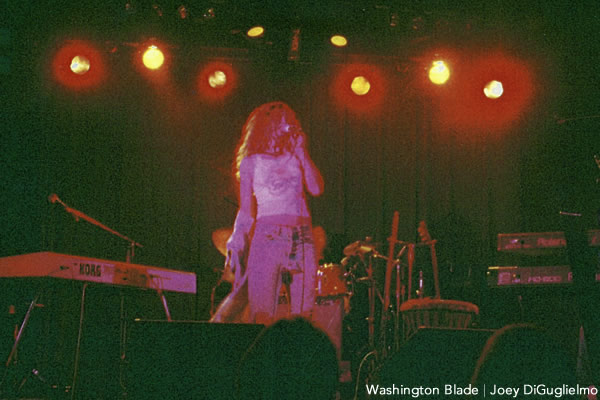
Sophie B. Hawkins at a 2004 Pittsburgh concert. (Washington Blade file photo by Joey DiGuglielmo)
a&e features
Have yourself a merry John Waters Christmas
Annual holiday show returns to Alexandria and Baltimore
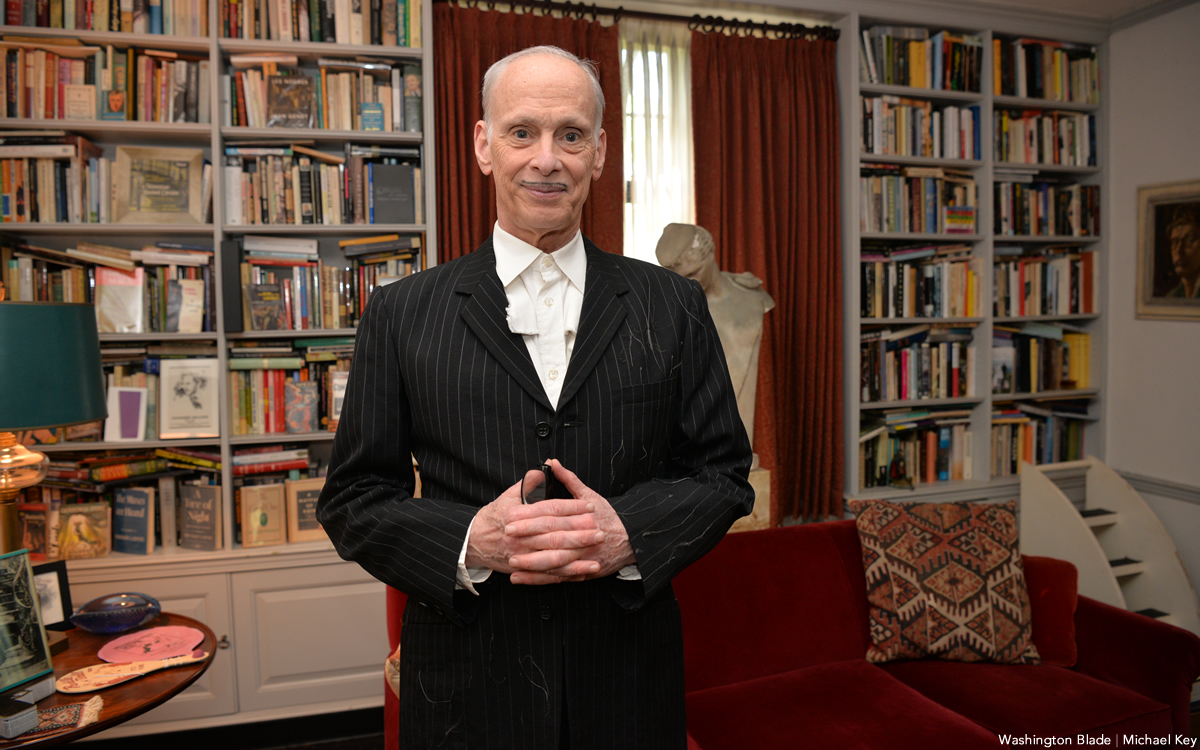
When it comes to iconic Christmas scenes in movies, none can top the tree-toppling tantrum thrown by cha-cha heels-deprived Dawn Davenport in John Waters’s fifth full-length feature “Female Trouble” from 1974. Therefore, it’s not surprising that Waters continues to make art out of Christmas, performing his spoken word Christmas tour in cities across the country. Waters has even more reason to celebrate with the release of his new red vinyl 7” single, a cover of Little Cindy’s “Happy Birthday Jesus (A Child’s Prayer)” on the A-side, and “A Pig Latin Visit From St. Nicholas” on the B-side. If you’re still looking for unique Christmas gifts, consider this record. As always, John was kind enough to make time for an interview in advance of his tour dates.
BLADE: John, in preparation for this interview with you, I went back and listened to Little Cindy’s original rendition of “Happy Birthday Jesus (A Child’s Prayer)” on your “A John Waters Christmas” CD.
JOHN WATERS: One thing I did, if you notice, I make the same stumble in my recording that she did in the original.
BLADE: It sounded to me like she got choked up.
WATERS: No, I think she just stumbles over a word, so I stumbled over the same word. It’s appropriation, insanely.
BLADE: Is this a song you first became aware of in your youth or when you were an adult?
WATERS: When I was doing the Christmas album, I had this friend named Larry Benicewicz. He was kind of my idea man with music. He knew every single old record. I would say to him, “Weird Christmas songs,” when we were doing a soundtrack, or a song about bears, or a song about this, and he would give me all these tapes. It was one of the ones he played for me. A lot of the songs I put in my movies and on my records, I did know as a kid. I did not know this one, but I immediately embraced it. I don’t think it’s campy. I think it really is spiritual in a weird way. My doing it makes it a novelty record. I am really for novelty records, and there aren’t any anymore. Why was there not a COVID novelty record? That’s insane. The dance “The Bug” that’s on the “Hairspray” soundtrack would be perfect for COVID.
BLADE: The thing that struck me was that for a Christmas song in the voice of a child, a kind of death pall hangs over it, with lines like, “If I was good you’d let me live with you” and “they nailed you to the cross, they wanted you to die.”
WATERS: All of it! When I see children at midnight mass kneeling in front of a nude man nailed to a cross, I feel like I’m at The Eagle! It is S&M, it’s creepy. I took the same cover (photo) from her record to parody and put my face on it. The same thing I did with The Singing Dogs last year when I covered (their version of) “Jingle Bells.” I’m really into novelty records. I love them and I’m trying to bring them back. I don’t expect anybody to ever play these records. Even The Singing Dogs one said on it, “Please do not play this record” [laughs]. And the flipside, the Pig Latin version, is almost impossible to listen to.
BLADE: I’m so glad you mentioned that. “A Pig Latin Visit From St. Nicholas” reminded me of the lost art of speaking in Pig Latin. I also recall watching the PBS series “Zoom” as an adolescent and learning to speak “ubbi dubbi,” a distant relative of Pig Latin. Do you think that the time is right for a Pig Latin or ubbi dubbi revival?
WATERS: Here’s the thing, I never could pick up any language, except Pig Latin. I’ve been in every foreign country. Foreign countries have given me money to learn to speak the language. I can never do it! But Pig Latin…my parents and other parents in the ‘50s spoke Pig Latin so kids couldn’t understand what they were saying. Then my mother taught it to me, and I used it. The hardest take to shoot in “Pink Flamingos” was not eating the dog shit. It was when the cast skipped, in one take, saying “E-way, are-yay e-they ilthiest-fay eople-pay in-hay e-they ole-hay ide-way orld-way.” We’re the filthiest people in the whole wide world in Pig Latin. We had to do so many takes so they could do it once without screwing it up. In “Polyester,” Edith (Massey) answers the phone, “ello-hay.” I did a photo piece where it was all subtitled in Pig Latin. Like “osebud-Ray” (from “Citizen Kane”) or in “Streetcar,” “ella-Stay!” [Laughs] All the iconic dialogue translated into Pig Latin. My assistant who helped me do it, had never heard of Pig Latin. She really got good at it because she lived in many foreign countries and can pick up languages. But it’s not that easy to do it correctly and read it. Your computer will translate into Pig Latin.
BLADE: AI understands Pig Latin?
WATERS: I guess that’s AI. It wasn’t 100% right, but it was close. I can speak it if I look at it, but just do a bit at a time. It was a challenge that no one would possibly care about or want to do.
BLADE: I think you pulled it off very well.
WATERS: If you want people to leave on Christmas morning, you put it on. That’s how you get your guests to leave. It’s time to go.
BLADE: Ood-gay i-bay! How did your relationship with record label Sub Pop, which released 2021, 2022, 2024, and new 2025 holiday singles, come about?
WATERS: I believe the first thing I did for them was “Prayer to Pasolini.” They came to me through Ian Brennan. He’s won a couple Grammys for World Music, but he is also is one of my agents who does the Christmas tour and a lot of my shows, anything with music. He helped me arrange each one of the songs. He had a relationship with Sub Pop. It was perfect. My friends in Baltimore, (the band) Beach House, have had huge success.
BLADE: That’s right, they’re on Sub Pop!
WATERS: Yes! I’m happy to be on it. I’ve even been to the warehouse and posed for pictures like Jackie Suzanne used to do.
BLADE: Is there any chance that “A John Waters Christmas” might be reissued on vinyl by Sub Pop?
WATERS: No. It’s such a nightmare to get the rights and to renew them. You have to find the publisher and the writer, and they usually hate each other. It doesn’t matter if it’s obscure or famous, it’s hard to get. You have to make the deal. The singer doesn’t get anything unless they play it on the radio. It would be so complicated legally, and there would be such a [laughs] tiny audience for it. I hope it will come out again. The same thing with the one for Valentine’s Day. I had two of them that did quite well when they came out; “A Date With John Waters and “A John Waters Christmas.” The “John Waters Christmas” album is still the soundtrack that plays whenever I’m doing my spoken word Christmas show as people are entering the theater.
BLADE: Aside from your annual Christmas show tour, what else do you do for the holidays now, and are there any traditions that you’ve carried over from your family?
WATERS: Certainly! I have two sisters, my brother’s widow, and me, so there are four and we take turns each year to have the Christmas dinner. Mine was last year. An entire sit-down dinner. Mom’s China, the silverware, the entire full dinner. It’s pretty traditional. I don’t have a Christmas tree, but I do decorate the electric chair from “Female Trouble.” That is a tradition in my family. We do have Christmas decorations, but they’re usually weird ones that fans sent me. I have one with Divine knocking over the Christmas tree, and the Christmas tree lights up, all sorts of amazing things. There is definitely a tradition here that might be a little altered, but it is definitely a tradition. I used to have a giant party every year, but COVID ended that. I still wouldn’t want 200 people in my house breathing right now.
BLADE: I was looking at your tour schedule and wondered if there are any new cities in which you’ve never performed the John Waters Christmas show that have been added to this year’s schedule?
WATERS: I don’t think there’s a city in America in which I haven’t done one show! The only places I haven’t been to are Hawaii and Alaska. I could do it there, but it’s too long on a tour. I can’t think of a city I haven’t played in in America over the last 50 years. The Christmas show is completely different every year. It doesn’t matter if you saw it last year.

Some gifts scream practical, others whisper luxury, and a few flat-out blur the lines. From cocoa that feels ceremonial to a cologne that linger like a suggestive smirk, this year’s ultimate gift picks prove that thoughtful (and occasionally naughty) presents don’t have to be prosaic. Welcome to your holiday cheat sheet for festive tangibles that get noticed, remembered, and maybe even result in a peck of gratitude planted under the mistletoe. Consensually, of course.
Amber Glass Champagne Flutes
Pop the champs – but make it vintage. These tulip-shaped stunners in amber-tinted glass bring all the Gatsby vibes without the Jazz-age drama. Whether you’re toasting a milestone or celebrating a Tuesday, their seven-ounce capacities and hand-wash-only care make ‘em as practical as they are pretty. Pair with a thoughtful bottle of bubs and gift with a glittering wink. $18, NantucketLooms.com
Disaster Playbook by Here Comes the Apocalypse
Because the end of the world shouldn’t be a solo act, this spiral-bound guide is your step-by-step roadmap to surviving and thriving when everything else goes sideways, which might be sooner than you think. Packed with checklists, drills, and a healthy dose of humor, it’s like a survival manual written by your most prepared (and slightly snarky) friend. Whether you’re prepping for a zombie apocalypse or, more realistically, REVOLUTION!, this playbook’s got your back. $40, HereComesTheApocalypse.com
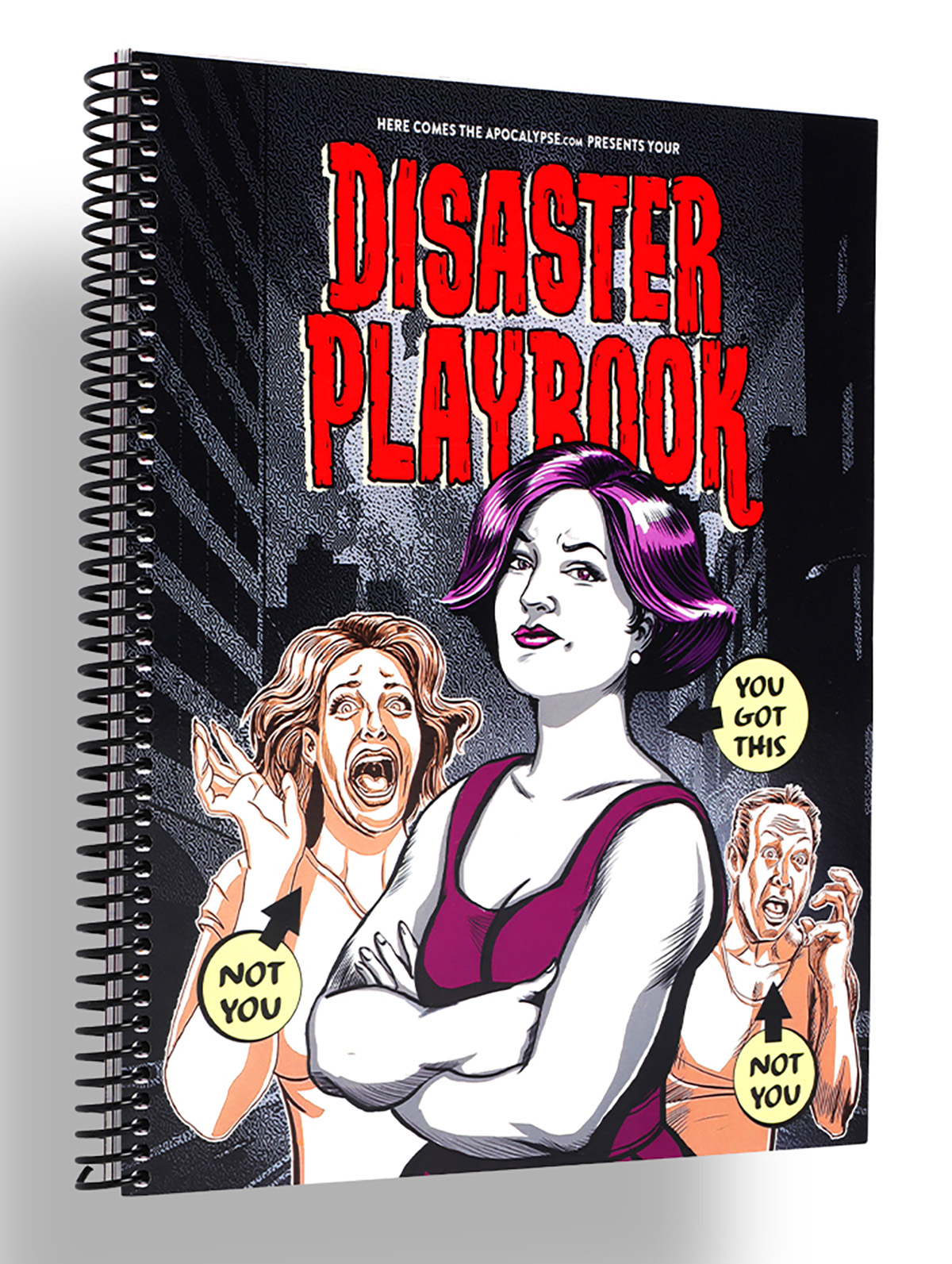
Wickless Vulva Candles
Bold, luxurious, and completely flame-free, CTOAN’s wickless candles melt from beneath on a warmer, releasing subtle, sophisticated fragrances, like sandalwood or lavender. The vulva-shaped wax adds a playful, provocative element to any space –perfect for a bedroom, living room, or anywhere you want elegance with an edge. A gift that celebrates form, intimacy and self-expression, no fire required. $39, CTOANCO.com
Villeroy & Boch Royal Classic Christmas Collection
Every meal is a mini celebration – with whimsy at every place setting – in Villeroy & Boch’s Royal Classic festive dinnerware collection that hits all the right notes. Made from premium German porcelain, it features nostalgic little toys, nutcrackers, and rocking horses in delicate relief, giving your holiday spread a playful but refined twist. Dishwasher- and microwave-safe, it’s luxe without the fuss. Gift a piece to a special someone, or start a collection they’ll use (and show off) for years to come. $22-$363, Villeroy-Boch.com
Greenworks Electric Lawnmower
You a ’hood queen who considers lawn care performance art – or just wants to rule the cul-de-sac in quiet, emission-free glory? Greenworks’ zero-turn electric mower has the muscle of a 24-horsepower gas engine but none of the fumes, drama or maintenance. Six 60V batteries and a 42-inch deck mean you can mow up to two-and-a-half acres on a single charge – then plug in, recharge, and ride again. It’s whisper-quiet, slope-ready, and smooth enough to make you wonder why you ever pushed anything besides your queer agenda. The perfect gift for the homeowner who loves sustainability, symmetry, and showing off their freshly striped yard like that fresh fade you get on Fridays. $5,000, GreenworksTools.com
Molekule Air Purifier
For the friend who treats their space like a sanctuary (or just can’t stand sneezes), the Molekule Air Pro is magic in motion. Covering up to 1,000 square feet, it doesn’t just capture allergens, VOCs, and smoke – it destroys them, leaving your air feeling luxury-clean. FDA-cleared as a Class II medical device, it’s serious science disguised as modern design. Gift it to your city-dwelling, pet-loving, candle-burning friend who likes their living room as pristine as their Instagram feed. $1,015, Molekule.com
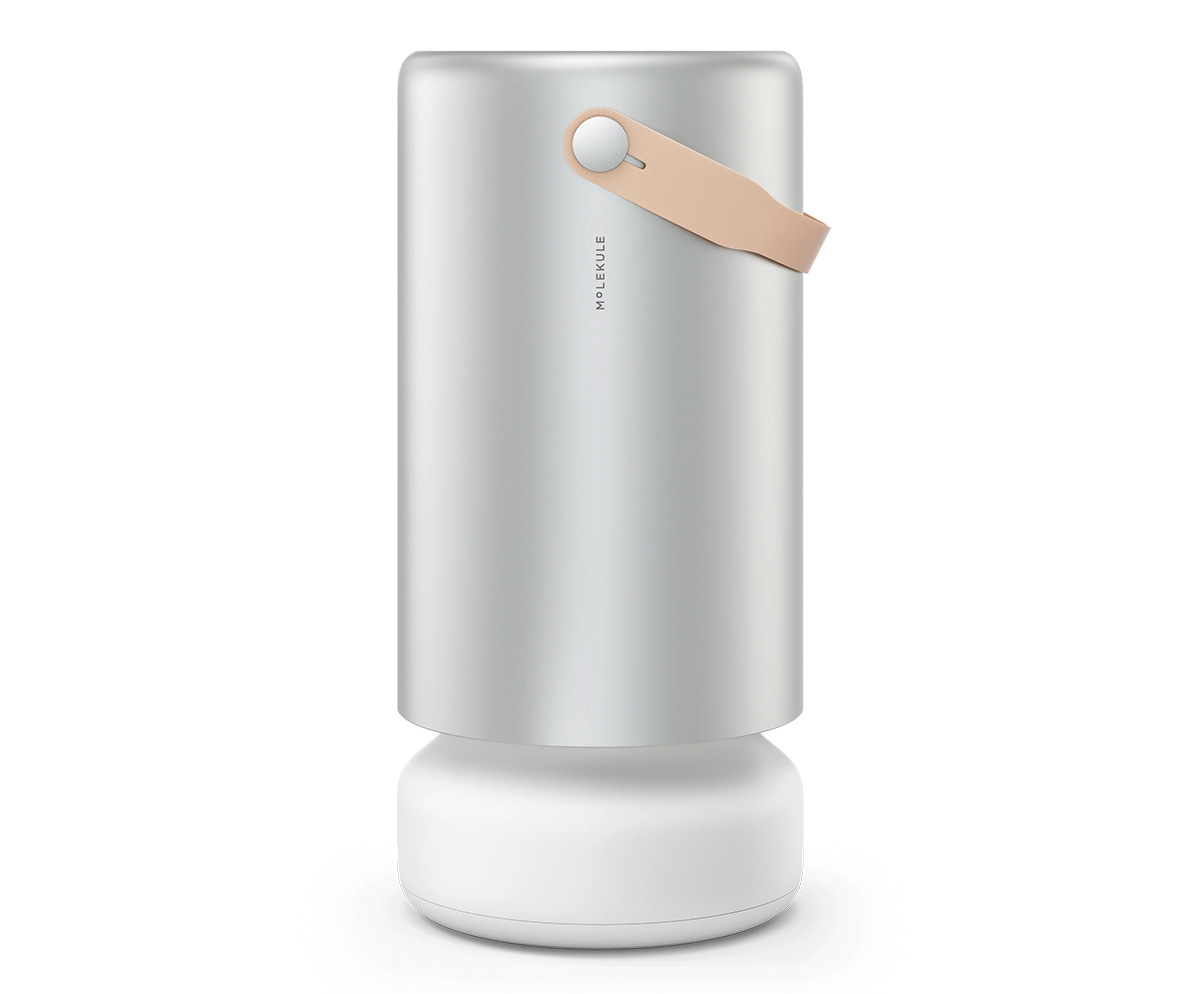
Cipriani Prosecco Gift Set
Effervescent with stone-fruit sweetness and a touch of Italian flair, the Cipriani Bellini & Prosecco gift set brings brunch-level glamour to any day of the week. The Bellini blends rich white-peach purée with sparkling wine, while the dry ’secco keeps things crisp and celebratory. Pop a bottle, pour a flute, and suddenly winter weeknights feel like a party – even with your pants off. $36, TotalWine.com
Woo(e)d Cologne
British GQ recently crowned Woo(e)d by ALTAIA the “Best Date Night Fragrance,” and honestly, they nailed it. Confident without being cocky – smoky gaïac and Atlas cedarwood grounds the room while supple leather and spicy cardamom do all the flirting – it’s a scent that lingers like good conversation and soft candlelight. Gift it to the one who always turns heads – or keep it for yourself and let them come to (and then on) you. $255, BeautyHabit.com

Lococo Cocoa Kit
Keep the run-of-the-mill mugs in the cabinet this Christmas and pull out Lococo’s handcrafted Oaxacan versions that demand you slow down and sip like it matters. Paired with a wooden scoop, rechargeable frother, and Lococo’s signature spice hot-chocolate blend (vegan, gluten-free, with adaptogenic mushrooms), this holiday kit turns Mexi-cocoa into a mini ritual you’ll look forward to. Perfect for anyone who loves a little indulgence with a side of ¡A huevo! energy.
Manta Sleep Mask
Total blackout, zero pressure on the eyes, and Bluetooth speakers built right into the straps, this ain’t your mama’s sleep mask — but it could be. The Manta SOUND sleep mask features C-shaped eye cups that block every hint of light while ultra-thin speakers deliver your favorite white noise, meditation, or late-night playlist straight to your ears. With 24-hour battery life, breathable fabric, and easy-to-adjust sound, it turns any bed (or airplane seat) into a five-star sleep suite. Perfect for anyone who treats shut-eye like an art form (or just wants to escape their roommate’s late-night bingin’ and/or bangin’). $159, MantaSleep.com

Shacklelock Necklace
Turn the industrial-chic vibe of a shackle into a sleek statement. Mi Tesoro’s platinum-plated stainless-steel necklace sits on an 18-inch wheat chain, featuring a shackle-style latch pendant that’s waterproof, tarnish-free, and totally fuss-les. Beyond style, it nods to a classic gesture in the queer leather community: replacing a traditional Master lock with something elegant to quietly signal belonging to someone special. Wear it solo for a minimalist edge or layer it like you mean it; either way this piece locks in both your look and your intentions. $90, MiTesoroJewelry.com
Parkside Flask Mojave Edition
Wine nights get a desert glow-up with Parkside’s limited-edition 750-milliliter all-in-one flask draped in sun-washed bronze and badland hues like sage, sand, and terracotta – with magnetic stemless tumblers that snap on for effortless shareability. It keeps your vino chilled for 24 hours, pours without drips (no tears for spilled rosé, please), and even lets you laser-engrave your own mantra or inside joke. Perfect for picnics, surprise rooftop clinks, or gifting to your favorite wine (or desert) rat. $149, HighCampFlasks.com

Mikey Rox is an award-winning journalist and LGBT lifestyle expert whose work has published in more than 100 outlets across the world. Connect with him on Instagram @mikeyroxtravels.
a&e features
Meet Mr. Christmas
Hallmark’s Jonathan Bennett on telling gay love stories for mainstream audiences
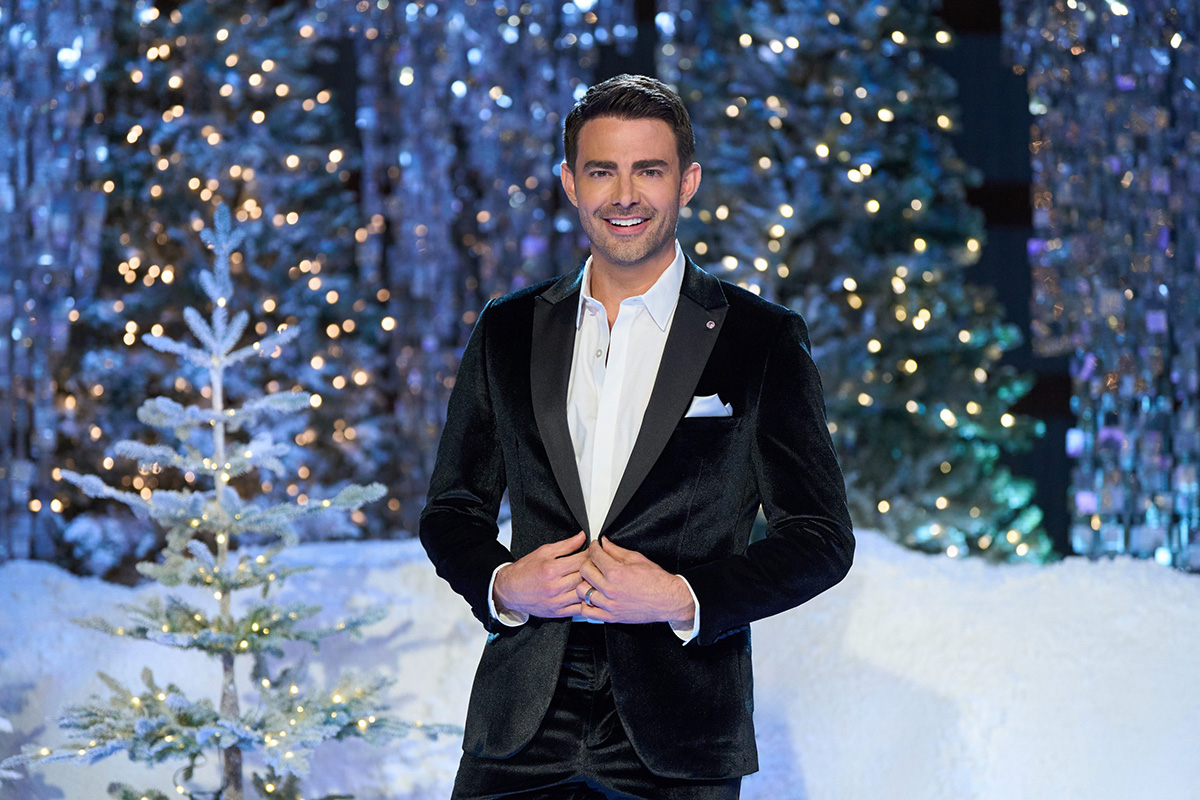
Jonathan Bennett believes there are two kinds of people in the world — those who love Hallmark movies and liars. And in Season 2 of Finding Mr. Christmas, which the Mean Girls star co-created with Ben Roy, Bennett is searching for Hallmark’s next leading man.
“It’s so fun for people because everyone in their life has someone they know that they think should be in Hallmark movies, right? The UPS driver, the barista at the coffee shop, the dentist,” Bennett says. “So we’re testing their acting abilities, we’re testing who they are, but we’re also looking for that star quality — the thing that makes them shine above everyone else. It’s almost something you can’t explain, but we know it when we see it.”
Season 2’s cast includes a former NFL player for the Green Bay Packers, a few actors, and a realtor. The 10 men compete in weekly festive-themed acting challenges, one of which included having to ride a horse and act out a scene with Alison Sweeney. The contestants were chosen from a crop of 360 potential men, and Bennett gives kudos to the show’s Emmy-nominated casting director, Lindsay Liles (The Bachelor, Bachelor in Paradise).
“She has a tough job because she has to find 10 guys that are going to be good reality television, but also have the talent to act, carry a scene, and lead a Hallmark movie eventually,” he says. To be the right fit for a Hallmark leading man, Bennett singles out five key characteristics: you have to be funny, charming, kind, have a sense of humor, and you have to do it all with a big heart.
Of course, Finding Mr. Christmas wouldn’t be Finding Mr. Christmas without its signature eye candy — something Bennett describes as “part of the job” for the contestants. “I can’t believe Hallmark let me get away with this. I dressed them as sexy reindeer and put them in harnesses attached to a cable 30 feet in the air, and they had to do a sexy reindeer photo shoot challenge,” he says with a laugh. “This season is just bigger and bolder than last. People are responding to not only all the craziness that we put them through, but also comparing and contrasting the guys in their acting scenes when we do them back-to-back.”
Season 1 winner Ezra Moreland’s career has been an early testament to the show’s success at finding rising talent. On seeing the show’s first winner flourish, Bennett says, “Now to watch him out in the world, just booking commercial after commercial and shining as an actor and a model, I think the show gave him the wings to do that. He learned so much about himself, and he took all that into his future auditions and casting. He just works nonstop. I’ve never seen an actor book more commercials and modeling gigs in my life.”
Bennett has been a star of plenty of Hallmark movies himself, including the GLAAD-award-winning The Groomsmen: Second Chances, which makes him a fitting host. Among those movies are 2020’s Christmas House, which featured the first same-sex kiss on the network and had a major impact on Bennett’s career as an openly gay man. “Hallmark’s been so great about supporting me in queer storytelling. But again, I don’t make gay movies for gay audiences. I make gay love stories for a broad audience, and that’s a huge difference, right? We’re not telling stories inside baseball that only the gay community will understand.”
He continues, “The backdrop of a Hallmark Christmas movie is very familiar to these people who watch. And so when you tell a gay love story, and you tell it no differently than a straight love story in that space, they’re able to understand. It’s able to change hearts and minds for people who might not have it in their lives.”
While Hallmark has become a major staple of Bennett’s career, he started off wanting to be a Broadway actor. And before the first season of Finding Mr. Christmas aired, Bennett took a break from TV to make his Broadway debut in Spamalot, replacing Michael Urie as Sir Robin and starring alongside Ethan Slater and Alex Brightman.
“That was my dream since I was five years old – then I booked a movie called Mean Girls, and everything kind of changes in your life. You no longer become a person pursuing Broadway, you become a part of pop culture,” Bennett recalls. “And to be honest, when I hit 40, I was like, ‘I’m probably never going to get to live that dream.’ And that’s okay, because I got to do other dreams and other things that were just as cool but different. So I honestly never thought it would happen.”
Bennett is still determined to make his way back on Broadway with the right role — he calls Spamalot the “best experience” of his life, after all — but he’s got another Hallmark show lined up with Murder Mystery House, which he co-created. The show was recently greenlit for development and intends to bring the Hallmark mystery movie to life. “It’s kind of like our version of The Traitors,” Bennett admits.
Looking back on both seasons, Bennett says that what makes Finding Mr. Christmas stand out in the overcrowded reality TV landscape is that everyone involved makes it with heart: “This isn’t a show where you’re going to watch people throw drinks in each other’s faces and get into big fights. The thing that has amazed me so much about this show, the more we’ve done it, is that every season, 10 guys come in as competitors, but they leave as a family and as brothers. That’s something you don’t get on any other network.”
Finding Mr. Christmas airs every Monday on Hallmark through December 20, with episodes available to stream on Hallmark+.



